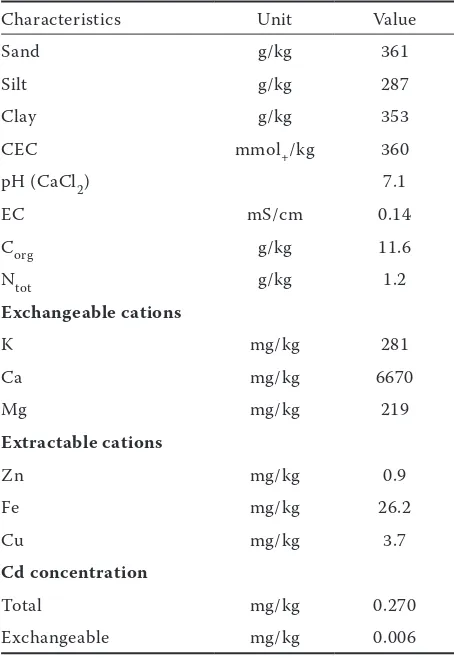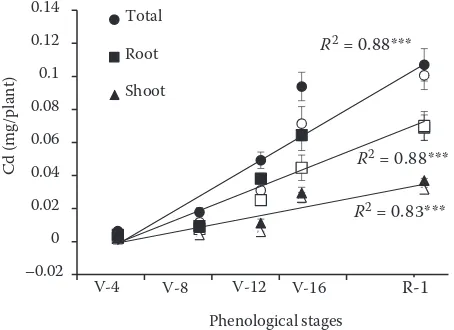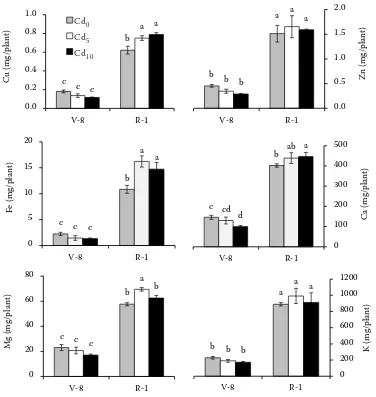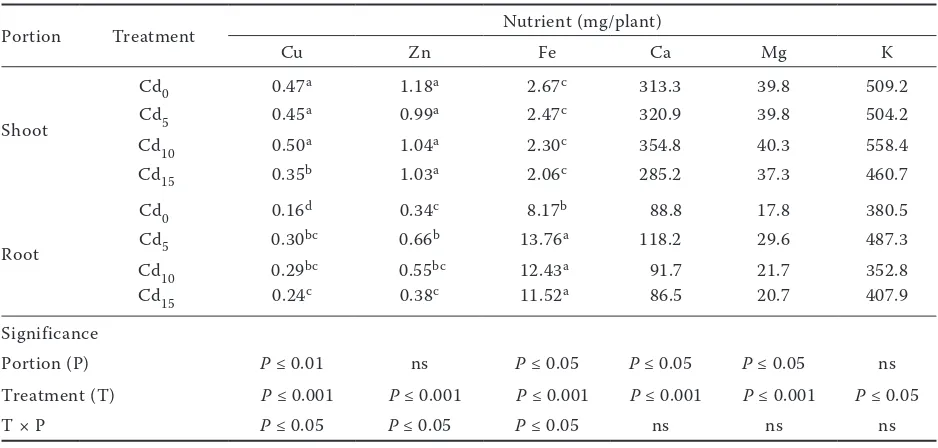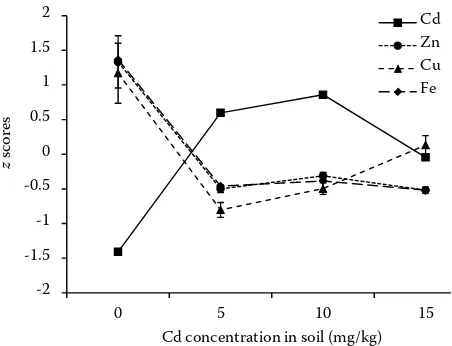In the last years, sunflower (Helianthus annuus L.), an increasingly important source of vegetable oil and biomass, usefully employed for chemical, energy and industrial purposes (Riva and Calzoni 2004), gained growing interest for phytoremedia-tion of organic pollutants and heavy metals. It ac-cumulates several metals in plant tissues, although metal uptake and distribution pattern seem to vary greatly with cultivars (Li et al. 1997), phenological stage (Madejón et al. 2003), level of contamination (Simon et al. 1998) and combination of metals (Niu et al. 2012). Cadmium, a non-essential metal, is taken up by membrane transporters of essential elements (Clemens 2006) and can interfere with the uptake, transport and physiological function of several elements (Das et al. 1997). It is usually stored in large amounts in the roots without caus-ing macroscopic stress symptoms in sunflower plants (Simon et al. 1998, Rivelli et al. 2012). It
was reported that Cd differently influences nu-trient content depending on species, varieties, growth stages and plant portion (Liu et al. 2003, Gonçalves et al. 2009). In sunflower only few stud-ies are available about the effect of toxic metals on nutrient uptake and translocation from root to the aboveground parts, and contradictions exist between the results of the experiments. Simon et al. (1998) showed that nutrient content in plant was unaffected by Cd soil contamination (1 and 10 mg Cd/kg soil) with only exception of Ca, Mn and Fe in head. Instead, Rivelli et al. (2012) found that K, Mg and Fe increased in root whereas Ca decreased in leaves of sunflower as effect of low level of Cd contamination (5 mg Cd/kg soil). Furthermore, toxic metal and nutrient contents in sunflower plants grown on pluri-contaminated soil varied depending on plant age (Madejòn et al. 2003, De Maria and Rivelli 2013). The aim of this study was
Assessment of cadmium uptake and nutrient content
in sunflower plants grown under Cd stress
A.R. Rivelli
1, M. Puschenreiter
2, S. De Maria
11
School of Agricultural, Forestry, Food and Environmental Sciences, University
of Basilicata, Potenza, Italy
2
Department of Forest and Soil Sciences, University of Natural Resources and Life
Sciences, Vienna, Austria
ABSTRACT
Sunflower plants were grown on soil contaminated with several levels of Cd (from 0.3 to 15 mg Cd kg/soil). Cd and nutrient (Cu, Zn, Fe, Ca, K, Mg) contents were evaluated in root and aboveground biomass during the vegetative growth period (from the emergence of the cotyledon leaves to the flower bud phase). An overall increase of Cd con-tent was found in the plants during the growing cycle. Significant interactions were found between Cd contamina-tion levels and phenological stages for Cu, Fe, Ca and Mg content in the whole plant. Cd levels involved significant increases of such nutrients only at the flower bud phase. At this stage, significant interactions between Cd levels in soil and plant portions (root and shoot) were found only for micronutrients (Zn, Cu, Fe). The translocation of mi-cronutrients from root to the shoot was negatively affected by Cd, which probably interferes with the mechanisms of the element transport in the plant. Root stored about 70% of the total Cd and showed greater imbalance in nutrient content compared to the aboveground portion. Cadmium affects plant nutritive status in a different way depending on Cd contamination level, nutrient considered, plant portion and phenological stage.
to evaluate the effects of a wide range of soil Cd contamination levels (from 0.3 to 15 mg Cd/kg soil) on Cd and nutrient (Cu, Zn, Fe, Ca, Mg and K) content and their interaction in root and above-ground biomass of sunflower. Plant growth and physiological response to Cd stress were reported in a previous paper (De Maria et al. 2013).
MATERIAL AND METHODS
Sunflower (Helianthus annuus L., cv. Oleko) was subjected to 6 levels of Cd contamination cor-responding to: 2.5; 5; 7.5; 10; 12.5; 15 mg Cd/kg soil (referred to as Cd2.5 through Cd15) with an untreated soil as a control (Cd0). The plants were grown in controlled glasshouse in plastic pots (each of 20 cm in diameter and 80 cm in height) filled with 10 kg of soil (whose characteristics are shown in Table 1) and divided into 7 groups to which, except the untreated control, CdSO4 solutions were applied bringing the soil to the maximum water holding capacity. Seeds were pre-germinated and then planted one per pot. Seventy-six pots were set up in a completely randomized design and each treatment was replicated 4 times; 48 pots (only for Cd0, Cd5 and Cd10 treatments) were harvested during the vegetative growing cycle at the stages V-4, V-8, V-12, V-16 (corresponding respectively to 4, 8, 12, 16 true leaves at least 4 cm in length); 28 pots (for all 7 treatments) were col-lected at the flower bud stage R-1 (when the ter-minal bud forms a miniature floral head rather than a cluster of leaves); the phenological stages were classified according to Schneiter and Miller (1981). At each harvesting time, plant biomass was divided in shoot and root. Roots were sonicated in 0.05 mol/L CaCl2 for 10 min in an ultrasonic bath (Elma Transsonic T 460/H, Hameln, Germany) and rinsed with deionised water. All samples were oven-dried (70°C for 48 h), weighted to determine the dry matter (DM) and ground in a stainless box mill.
Cd content in root and shoot was determined at stages V-4, V-8, V-12, and V-16 in selected treat-ments (Cd0, Cd5 and Cd10) and at the flower bud stage R-1 in all 7 treatments. Nutrient content (Cu, Zn, Fe, Ca, K, Mg) was determined at V-8 stage (in Cd0, Cd5, Cd10 treatments) and at R-1 stage (in Cd0, Cd5, Cd10, Cd15 treatments). Subsamples of 0.5 g were digested for 32 min in a microwave digestion unit (Milestone 1200 MEGA, Bergamo, Italy) by using 5 mL HNO3 and 1 mL H2O2; after that 50 mL
of distilled water were added to the sample volume. Then Cd and nutrient concentration of all samples were determined by a spectrometer (ICP-OES, Thermo Scientific iCAP 6000 Series, Cambridge, UK).
Soil samples were processed to determine ex-tractable and total metal fraction. For measure-ment of extractable metal fraction, 20 g of dry soil were shaken with 1 mol/L of NH4NO3 solution, according to the DIN V 19730 (1993) procedure. For total metal fraction, 0.5 g of soil were digested with aqua regia and H2O2 in a microwave diges-tion unit (Milestone 1200 MEGA) as described by Leita and Petruzzelli (2000). The elemental concentration of soil samples were determined by an ICP-OES spectrometer.
Certified reference material was always digested and analyzed together with the soil and tissue samples for quality assurance.
[image:2.595.304.531.400.729.2]The element content was determined by mul-tiplying the concentration of each tissue by the respective DM. The translocation factor (TF) was
Table 1. Experimental soil properties
Characteristics Unit Value
Sand g/kg 361
Silt g/kg 287
Clay g/kg 353
CEC mmol+/kg 360
pH (CaCl2) 7.1
EC mS/cm 0.14
Corg g/kg 11.6
Ntot g/kg 1.2
Exchangeable cations
K mg/kg 281
Ca mg/kg 6670
Mg mg/kg 219
Extractable cations
Zn mg/kg 0.9
Fe mg/kg 26.2
Cu mg/kg 3.7
Cd concentration
Total mg/kg 0.270
Exchangeable mg/kg 0.006
calculated as ratio between content of elements (Cd, Cu, Zn, Fe) in shoot and root. Values of TF were normalized through z scores standardization. The z score value is given by:
z = (x – µ)/σ
Where: x – TF value of each sample; µ and σ are average and standard deviation of TF values for each element, respectively.
Statistical analysis was performed by the R soft-ware (version 2.10.1, R Foundation for Statistical Computing, Vienna, Austria).
RESULTS AND DISCUSSION
During the vegetative growth period, Cd5 and Cd10 treatments did not differ from each other regarding the content of Cd in total plant, root and shoot; as a consequence, only three regres-sion lines were displayed in Figure 1. Cd signifi-cantly and linearly increased over time in plants passing, on average, from 0.005 mg Cd/plant at V-4 stage to 0.1 mg Cd/plant at R-1 stage. During the vegetative stages V-4 and V-8, root and shoot showed similar Cd amount, after that root retained almost 70% of the total Cd. Similarly, in each stage considered, no differences among treatments were found in dry matter production, that was in shoot and root, respectively, 1.2 and 0.19 g/plant at V-4, 5.1 and 0.95 at V-8, 18.7 and 4.8 at V-12, 34.8 and 8.0 at V-16 and 53.6 and 9.5 at R-1 (on average of the treatments). Therefore, a significant positive relationship was found between the dry matter production and Cd content in plant (R2 = 0.95; P ≤ 0.001, data not shown). In the preview pa-per, we reported that, regardless of the Cd levels in the soil, the concentration of Cd in shoot was reduced over time of about 70% passing from the early stage to the end of the vegetative growing phase, whereas in root it declined by about 57% (De Maria et al. 2013). The differences observed between content and concentration in tissues could indicate that although Cd continues to enter into the plant during the vegetative growing cycle, the uptake rate is reduced with time relative to the bio-mass increase. As recently summarized by Hossain et al. (2012), plants employ various strategies to cope with toxic effects of heavy metals, and the resistance to heavy metal stress can be achieved by reducing the concentration of metals entering the cell by extracellular precipitation, biosorption
[image:3.595.307.534.495.660.2]to cell walls, reduced uptake, or increased efflux. Furthermore, plants have a range of detoxification and tolerance mechanisms that appear to be in-volved primarily in avoiding toxic concentrations at sensitive sites within the cells, thus preventing damaging effects (Hall and Williams 2003). As a result, metals in excess are often stored in roots, where physiological processes are less affected. Accordingly, De Maria et al. (2013) found that sunflower grown on contaminated soil tends to ac-cumulate Cd mainly in root and old leaves without significant detrimental effects on plant growth and physiological parameters, except for chlorophyll content. It is well established that Cd can interfere with the uptake, transport and physiological func-tion of several elements (Das et al. 1997). In our study the nutrient content in plant increased over time but, unlike expected, it significantly varied among the treatments only at R-1 stage, whereas no differences were observed at V-8 stage, except for Ca content (Figure 2). Significant interactions between phenological stages and soil Cd levels were found for all nutrients, except for Zn and K. Instead, Cu, Fe and Ca seem to be similarly affected by Cd, as their content increased with respect to the uncon-taminated control. Recently, Rezvani et al. (2012) reported that Cd supply increased macronutrients and decreased micronutrients concentrations in plant of Aeluropus littoralis. Specific mechanisms seem to be involved to maintain homeostasis, i.e.
Figure 1. Cd content in total plant, root and shoot of sunflower subjected to two levels of Cd soil contamina-tion (Cd5, white symbols; Cd10, black symbols) during the vegetative growing cycle (V-4, V-8, V-12, V-16) and flower bud stage (R-1). Values are means (n = 4) ± S.E.; the asterisks indicate the significance level of
F-ratio: ***P ≤ 0.001
V-16 V-12
V-8 R-1
V-4
R² = 0.8825
R² = 0.8825
R² = 0.8319
–0.02 0 0.02 0.04 0.06 0.08 0.1 0.12 0.14
Cd
(m
g/
plan
t)
Phenological stages Total
Root Shoot
R-1
R2 = 0.88***
R2 = 0.88***
a balance between having enough essential metals available for metabolic functions and at the same time avoiding toxicity and to keep nonessential met-als below their toxicity thresholds (Clemens 2006). De Maria and Rivelli (2013) found that passing from flowering to maturity stage of sunflower plants, Cd, Cu and Zn (given at toxic concentrations in soil) increased in the older leaves and stem decreasing in head, suggesting a possible effect of metal re-translocation in plant to preserve reproductive and photosynthesizing tissues. In the same study, it was shown that in sunflower seeds the concen-tration of toxic metals never exceed the toxicity threshold values considered for livestock food. Clemens (2006) summarized processes involved in the uptake, sequestration and translocation of
Cd in plant roots, highlighting that Cd could be taken up into plant cells by Fe and Zn transporters and then stored mainly in the vacuoles through metal binding peptides, i.e. phytochelatins (PCs). It was shown that the levels of PCs in sunflower increase as effect of increasing Cd levels and time of exposure (Yurekli and Kucukbay 2003). PCs are also involved in the homeostasis of Zn and Cu by providing a transient storage form for the ions (Thumann et al. 1991). Considering our results, the variation in nutrient content as effect of Cd could be due to a series of defence mechanisms, e.g. PCs production, expressed by sunflower to avoid toxicity.
[image:4.595.109.485.85.482.2]At the flower bud stage (R-1), considering all treatments tested, Cd significantly increased in
Figure 2. Nutrient content (Cu, Zn, Fe, Ca, Mg, K) in sunflower plants at two phenological stages (V-8 and R-1). Values are means (n = 4) ± S.E.; for each element, bars followed by the same letters are not significantly different for P ≤ 0.05 according to the Duncan’s test
plants as effect of increased levels of Cd in soil (Figure 3); in particular, in the whole plant Cd in-creased from 0.04 mg Cd/plant in Cd2.5 to 0.12 mg Cd/plant in Cd15. The highest increase in the Cd content was observed passing from Cd2.5 to Cd5 treatment and it remained almost constant for higher levels of Cd contamination (from Cd5 to Cd15). Considering all treatments, about 70% of
[image:5.595.62.291.84.252.2]total Cd content was found in root, except for Cd2.5 treatment wherein Cd was retained almost to 100% in root. Therefore, the translocation of Cd from the root to the shoot occurred when Cd contamination exceeded 2.5 mg/kg of soil. Still at R-1 stage, regardless of the treatments, the highest contents of Ca, K, Mg, Cu and Zn oc-curred in the shoot whereas, as observed for Cd, the Fe content was higher in the root (Table 2). Almost all analysed nutrients were affected by Cd supply, but significant interactions between Cd contamination and nutrient contents in root and shoot were found only for Cu, Zn and Fe (Table 2). Such results indicate that Cd affected the trans-location of Cu, Zn and Fe from the root to the shoot. To facilitate comparisons between Cd and nutrient translocation, the values of translocation factor were normalized as z scores (Figure 4). As expected, Cd value in the Cd0 treatment is below zero (which is the level corresponding to the mean value of translocation of each element). In the same treatment the values of Zn, Cu and Fe are higher compared with values of the con-taminated treatments. Interestingly, the values of Cd were always in reverse order with respect to those of the nutrients, indicating that when Cd is translocated to the shoot, the translocation of nutrients is reduced. Differences in absorption and
Figure 3. Cd content in total plants, root and shoot of sunflower subjected to several levels of Cd soil contami-nation at the flower bud stage (R-1). Values are means (n = 4) ± S.E.; the asterisks indicate the significance level of F-ratio: **P ≤ 0.01
Table 2. Nutrient content in shoot and root of sunflower plants subjected to several Cd contamination levels
Portion Treatment Nutrient (mg/plant)
Cu Zn Fe Ca Mg K
Shoot
Cd0 0.47a 1.18a 2.67c 313.3 39.8 509.2
Cd5 0.45a 0.99a 2.47c 320.9 39.8 504.2
Cd10 0.50a 1.04a 2.30c 354.8 40.3 558.4
Cd15 0.35b 1.03a 2.06c 285.2 37.3 460.7
Root
Cd0 0.16d 0.34c 8.17b 88.8 17.8 380.5
Cd5 0.30bc 0.66b 13.76a 118.2 29.6 487.3
Cd10 0.29bc 0.55bc 12.43a 91.7 21.7 352.8
Cd15 0.24c 0.38c 11.52a 86.5 20.7 407.9
Significance
Portion (P) P ≤ 0.01 ns P ≤ 0.05 P ≤ 0.05 P ≤ 0.05 ns
Treatment (T) P ≤ 0.001 P ≤ 0.001 P ≤ 0.001 P ≤ 0.001 P ≤ 0.001 P ≤ 0.05
T × P P ≤ 0.05 P ≤ 0.05 P ≤ 0.05 ns ns ns
Values are means (n = 4). Data were analyzed independently by two way ANOVA to evaluate the effects of portion, treatment and the interaction between them on nutrient content. The significance level of F-ratio is given for all factors and interactions. For each nutrient values followed by the same letters are not significantly different for
P ≤ 0.05 according to the Duncan’s test; ns – not significant
R² = 0.9164
R² = 0.868.15
R² = 0.8946
–0.02 0.00 0.02 0.04 0.06 0.08 0.10 0.12 0.14 0.16
0 2.5 5 7.5 10 12.5 15
C
d
(mg
/p
la
nt
)
Cd concentration in soil (mg/kg) Total
Root Shoot
R2 = 0.92**
R2 = 0.87**
[image:5.595.63.532.481.705.2]translocation capacities of nutrients in plants as effect of the interactions among Cd and nutrients were already reported by Herrero et al. (2010). Liu et al. (2003) showed that the effects of Cd on the mineral nutrients in the roots and leaves of rice were mostly significant but varied with metal ele-ments, organs and growing stages. Metal uptake and partitioning to plant organs and cell types, as well as metal storage and re-mobilization all require the operation of transition metal trans-porters (Krämer et al. 2007). A lack of specificity of uptake and distribution systems also leads to the accumulation of non-essential metals as Cd (Clemens 2006). For example, the nicotianamine (a non-protein amino acid found in all plants), that is linked with Fe, Cu and Zn homeostasis in plant and is involved in maintaining the mobility of such metal ions in vascular tissues and between cells (Krämer et al. 2007), seems to be involved also in Cd chelation, transport and detoxification (Sharma and Dietz 2006). Liu et al. (2003) found that the interactions of Cd and Fe, Zn and Cu are synergetic in uptake and translocation from root to shoot by rice plants. Our results showed that Cu, Zn and Fe contents in sunflower root generally increased by increasing the level of Cd soil contamination but their translocation from root to the shoot was reduced, suggesting that complex interactions can be involved between toxic and nutrient elements with synergistic or antagonistic effects between them, depending on nutrient element and plant portion. Despite symptoms of Cd toxicity were related to interactions between the uptake and
translocation of nutrients in plant (Rezvani et al. 2012), we did not find any visible symptom of Cd toxicity probably because the content of nutrients remained in the normal range. Even though the re-sults on metal-induced plant stress were frequently reported, there is still a need for answering further questions on the factors that modulate the signal-ing pathways in response to Cd stress (Azevedo et al. 2012). Our results, although they are to be tested in open field, provide useful information about the interaction between Cd and essential elements in sunflower plants; as highlighted by Liu et al. (2003) the interactions between Cd and other elements may provide clues to explain the nature of Cd accumulation in crops. In addition, according to Dickinson et al. (2009), it is impor-tant to treat skeptically any data obtained from hydroponics, pot experiments, or spiked soils on the grounds that there is a high probability these methods will not accurately reflect concentrations in field-grown plants.
In conclusion, the effect of Cd contamination on nutrient content in sunflower plants varied depending on the Cd contamination level, nutrient considered, plant portion and phenological stage. Based on the responses to Cd contamination in controlled condition, sunflower appears promising for phytoremediation. Considering that the time of remediation is often a limiting factor in phytore-mediation technologies, sunflower biomass can be used to generate an alternative income for the farmer while remediating at the same time the soil, thus rendering the time constraint less important.
REFERENCES
Azevedo R.A., Gratão P.L., Monteiro C.C., Carvalho R.F. (2012): What is new in the research on cadmium-induced stress in plants? Food and Energy Security, 1: 133–140.
Clemens S. (2006): Toxic metal accumulation, responses to ex-posure and mechanisms of tolerance in plants. Biochimie, 88: 1707–1719.
Das P., Samantaray S., Rout G.R. (1997): Studies on cadmium toxicity in plants: A review. Environmental Pollution, 98: 29–36. De Maria S., Puschenreiter M., Rivelli A.R. (2013): Cadmium accumulation and physiological response of sunflower plants to Cd during the vegetative growing cycle. Plant, Soil and Environment, 59: 254–261.
De Maria S., Rivelli A.R. (2013): Trace element accumulation and distribution in sunflower plants at the stages of flower bud and maturity. Italian Journal of Agronomy, 8: 65–72.
-2 -1.5 -1 -0.5 0 0.5 1 1.5 2
0 5 10 15
z
sco
re
s
[image:6.595.65.291.86.259.2]Cd concentration in soil (mg/kg) Cd Zn Cu Fe
Dickinson N.M., Baker A.J.M., Doronila A., Laidlaw S., Reeves R.D. (2009): Phytoremediation of inorganics: Realism and syn-ergies. International Journal of Phytoremediation, 11: 97–114. DIN V 19730 (1993): Institut für Normung, Berlin.
Gonçalves J.F., Antes F.G., Maldaner J., Pereira L.B., Tabaldi L.A., Rauber R., Rossato L.V., Bisognin D.A., Dressler V.L., Flores E.M., Nicoloso F.T. (2009): Cadmium and mineral nutrient ac-cumulation in potato plantlets grown under cadmium stress in two different experimental culture conditions. Plant Physiology and Biochemistry, 47: 814–821.
Hall J.L., Williams L.E. (2003): Transition metal transporters in plants. Journal of Experimental Botany, 54: 2601–2613. Herrero E.M., López-Gonzálvez A., Ruiz M.A., Lucas-García J.A.,
Barbas C. (2010): Uptake and distribution of zinc, cadmium, lead and copper in Brassica napus var. oleifera and Helianthus
annuus grown in contaminated soils. International Journal of
Phytoremediation, 5: 153–167.
Hossain M.A., Piyatida P., da Silva J.A.T., Fujita M. (2012): Mo-lecular mechanism of heavy metal toxicity and tolerance in plants: Central role of glutathione in detoxification of reactive oxygen species and methylglyoxal and in heavy metal chelation. Journal of Botany, 2012: ID 872875. doi:10.1155/2012/872875 Krämer U., Talke I.A., Hanikenne M. (2007): Transition metal
transport. FEBS Letters, 581: 2263–2272.
Leita L., Petruzzelli G. (2000): Heavy metals. In: Angeli F. (ed.): Methods of Soil Chemical Analysis. Cap. XI, 1–18. (In Italian) Li Y.M., Chaney R.L., Schneiter A.A., Miller J.F., Elias E.M., Ham-mond J.J. (1997): Screening for low grain cadmium phenotypes in sunflower, durum wheat and flax. Euphytica, 94: 23–30. Liu J., Li K., Xu J., Liang J., Lu X., Yang J., Zhu Q. (2003):
Inter-action of Cd and five mineral nutrients for uptake and accu-mulation in different rice cultivars and genotypes. Field Crop Research, 83: 271–281.
Madejón P., Murillo J.M., Marañón T., Cabrera F., Soriano M.A. (2003): Trace element and nutrient accumulation in sunflower plants two years after the Aznalcóllar mine spill. Science of the Total Environment, 307: 239–257.
Niu Z.X., Li X.D., Sun L.N., Sun T.H. (2012): Changes of three organic acids in the process of Cd and Pb phytoextraction by
Helianthus annuus L. Plant, Soil and Environment, 11: 487–494.
Rezvani M., Zaefarian F., Miransari M., Nematzadeh G.A. (2012): Uptake and translocation of cadmium and nutrients by
Aelu-ropus littoralis. Archives of Agronomy and Soil Science, 58:
1413–1425.
Riva G., Calzoni J. (2004): Standardisation of vegetable oils. Italian Journal of Agronomy, 8: 9–15.
Rivelli A.R., De Maria S., Puschenreiter M., Gherbin P. (2012): Ac-cumulation of cadmium, zinc and copper by Helianthus annuus
L.: Impact on plant growth and uptake of nutritional elements. International Journal of Phytoremediation, 14: 320–334. Schneiter A.A., Miller J.F. (1981): Description of sunflower growth
stages. Crop Sciences, 21: 901–903.
Sharma S.S., Dietz K.J. (2006): The significance of amino acids and amino acid-derived molecules in plant responses and adaptation to heavy metal stress. Journal of Experimental Botany, 57: 711–726.
Simon L. (1998): Cadmium accumulation and distribution in sunflower plant. Journal of Plant Nutrition, 21: 341–352. Thumann J., Grill E., Winnacker E.L., Zenk M.H. (1991):
Reacti-vation of metal-requiring apoenzymes by phytochelatin-metal complexes. FEBS Letters, 284: 66–69.
Yurekli F., Kucukbay Z. (2003): Synthesis of phytochelatins in
Helianthus annuus is enhanced by cadmium nitrate. Acta
Botanica Croatica, 62: 21–25.
Received on July 17, 2013 Accepted on January 17, 2014
Corresponding author:
Susanna De Maria, Ph.D., University of Basilicata, School of Agricultural, Forestry, Food and Environmental Sciences, Via dell’Ateneo Lucano 10, 85100 Potenza, Italy
